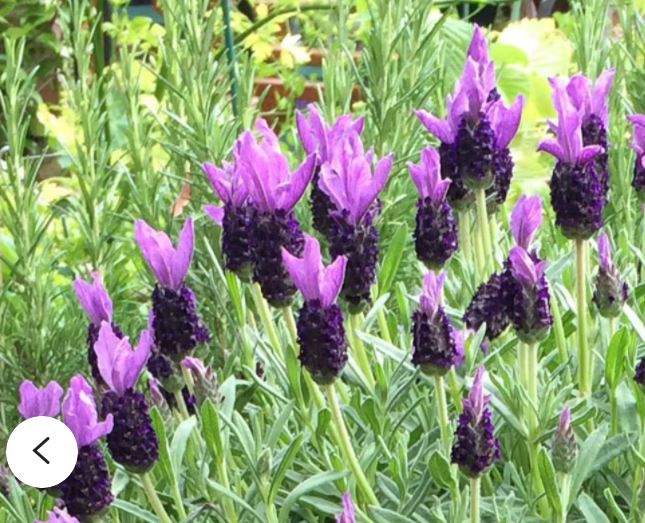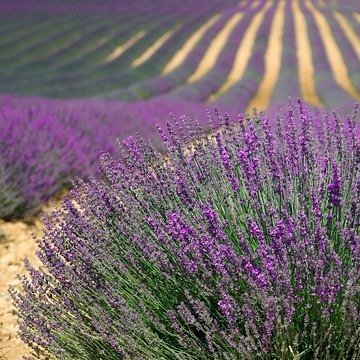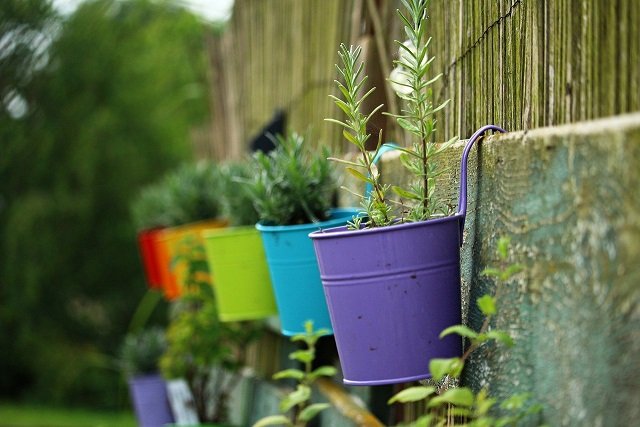Lavender is appealing in every way. Scenic to the eyes, serene to the nose.
Some of the best lavender plants to grow indoors are French lavender, English lavender, Fernleaf lavender, and Canary Island lavender.
Let us explain what makes these lavenders best for growing indoors.
Which Lavender Is Best For Growing Indoors?
When you first get the idea of growing lavender indoors you have to consider the conditions inside your house.
Then establish which variant of lavender would do best with the conditions you can provide it with.
Not every lavender can do well in indoor conditions but there are a few that will do better than others.
Here are the various lavender plants that are good for growing indoors. Pick out the one that fits your home and fulfills your requirements.
1. French Lavender (Lavandula dentata)

French lavender plants are the most popular lavender for growing indoors and should be your first choice.
Although they bear a milder lavender scent, they bloom for the longest time even under indoor conditions.
The plants themselves are evergreen and small. Leaves are short and sticky (due to oil production) showing off a green-grey color.
Leaves have serrations which is why this lavender is also called ‘fringed lavender’.
The violet-blue flowers extend from silvery-grey stems. These appealing flowers are surrounded by bracts.
Carry out deadheading to promote more intense flowering (flowering occurs up to 3 times a year). Pruning helps to keep the bush tidy but even then they can become woody.
Growing French lavender indoors is mandatory in colder regions since they cannot bear cold and frost.
You should make sure there is no humidity and no excess water. They are highly intolerant to moisture. They like alkaline soils and can possibly perish in acidic soils.
French lavender is very aromatic and flavorful, it finds much use in the aromatic and culinary industries. They are great for coloring and creating a lavender taste in desserts, jams, and biscuits.
A good French lavender plant for growing indoors is Lavandula stoechas
2. English Lavender (Lavandula angustifolia)

The most common type of lavender grown for commercial use is English lavender. This variant also makes for a great addition to the garden with its strong lavender aroma.
English lavender plants bear the largest assortment of flower colors and also the strongest scent among all lavenders.
Flowers range from dark purple to several shades of pink! A great feature of this lavender is they are available in three variants: tall, semi-dwarf, or tall.
English lavender is the most cold-hardy variant of lavender that can even withstand frost and harsh winters.
The soil must be alkaline (high lime content). Sandy soils with rocks and minimal nutrients replicate lavender’s natural soil, thus they thrive in such conditions.
Variants of English lavender good for growing indoors are:
- Lavandula hidcote
- Lavandula munstead
3. Fern-Leaf Lavender (Lavandula multifida)
Also known as Egyptian lavender or California lavender. This lavender has fern-like leaves that are grayish-green and appear to look like lace.
Like French lavender, these lavender shrubs are showy bearing bluish-purple flowers that make for an appealing houseplant.
When in their element, they can show excellent blooms that make it a great ornamental plant that flowers in summer.
These plants grow and flower best in hot sunny climates with relatively dry conditions. Well-draining alkaline soil is best for these plants and it is tolerant to salt and even pollution!
This makes it great for growing indoors in the inner city or urban areas.
Use them as hedges, or grow them in indoor pots and baskets. The latter may require a bit more watering.
Both leaves and flowers are important and can be harvested for herbal use and as a scent in potpourri.
The good news is this variant can survive for up to 10 years when given the best care and environment.
4. Canary Island Lavender (Lavandula canariensis)
Native to the Spanish Canary Islands, the foliage and flowers of this lavender variant do not bear any scent.
If you are growing them indoors, it will be just for their flowers. The lack of scent and flavor renders them almost useless but appealing.
The leaves are deep green-gray and are dainty and bear resemblance to the leaves of most ferns. Flowers range from brilliant blue to lilac and sit on special stalks that project from the foliage.
Canary Island lavender makes a great house plant because they tolerate a range of temperatures. They can even withstand temperatures up to 10℃ as long as frost is not involved.
Some people use this particular plant for folk medicine. It can be used to manage fever, insect bites, anti-parasitic treatment, and even as an anti-inflammation aid.
Like all lavender, they require poor sandy soil but they may have a desire for a lot of water (variant specific). These plants also have a slightly higher requirement for Calcium and Magnesium. But delivering these nutrients is manageable when using supplements.
They can bloom continuously for a while, making them great indoors or on sunny terraces and balconies.
Benefits of Growing Lavender Plants Indoors
Lavender can be both a herb and an ornamental plant. Here are the four reasons why you should grow lavender plants indoors.
a. Culinary
Lavender has found a unique home in the food industry. Cooling summer lemonades, alcoholic beverages, biscuits, desserts, and even meat marinades make use of either lavender stems or flowers.
b. Medicinal
The medicinal world has managed to unlock ways in which lavender can act as a natural remedy. The oils produced by the lavender plants can help with fever, headaches, and even as a relief from stress.
One particular use of dry lavender leaf sachets is to act as a sleeping aid when kept underneath a pillow.
c. Aromatic
Of course, lavender itself is a scent and can ward off unwanted household smells. Adding lavender to a mix of other scented herbs can make a mix called potpourri.
This scented mix is great to have around the house or even in the car!
d. Crafts
Because of their color and aroma, lavender flowers find themself at the center of a prolific craft industry. Soaps, candles, and handicrafts all use lavender for its soothing smell. Even bouquets with dry lavender are a common find.
Suitable Conditions For Growing Lavender Potted Plants Indoors
The exact same requirements that make a lavender flower outdoors will not work when it is indoors.
The lavender might be sheltered from the elements indoors but it needs more than that. For it to grow and bear a blossom of flowers you must provide the following conditions.
– Humidity
High humidity is not something that lavender will take well to. Even in the house, moisture should not accumulate especially if you are watering your lavender regularly.
Lavender likes low-humidity levels. This should be fine because most households have humidity levels that do not exceed 40%. Humidity levels that are high can entice fungal growth and may even contribute to root rot (overwatering).
These natural levels are adequate and you do not have to change them, but they should not increase! That means you should not move your pot plant to the bathroom or near wet areas like the sink.
– Sunlight
Your ability or inability to provide your lavender plants with enough hours of sunlight can decide their fate! Indoor lavender plants need as much sunlight as their outdoor counterparts.
The lavender pots must have 3 to 4 hours of sunlight a day. Placing them on a south-facing windowsill is usually successful to get the sun at its strongest.
The next best option is a west-facing window which gives long sun hours but not the hottest sun.
But what if you don’t have good sunlight accessing your home or apartment? Then you have to get a grow light.
Use a high output T5 fluorescent lamp, compact fluorescent, or even a LED (full spectrum) light. You must suspend this light 12 inches above the plants.
– Temperature
Growing lavender indoors needs slightly different temperatures at night compared to daytime temperatures.
These plants require slightly cooler temperatures in winter versus what it requires in other seasons. This might sound odd but it is an important requirement.
Giving in to your lavender’s temperature needs will lead to better flowering, more growth, and healthier leaves and stems.
To give you an idea of the varying temperature requirements, here are the exact temperatures.
From spring to mid-fall, temperatures should be 70℉ (21℃) during the day and 50-55℉ (10-13℃) at night.
In the latter part of the fall to winter temperature requirements differ. Temperatures by day should be 60-65℉ (15-18℃) while temperatures by night should be 45-50℉ (7-10℃).
Major deviations from these temperatures will take an effect on the lavender plants you are growing indoors. Perhaps they will not grow or bloom poorly if they bloom at all!
– Watering
Traditionally outdoor lavender plants are supposed to be watered scarcely to avoid overwatering and after all, they are drought-resistant.
But this is not exactly the case with potted lavender plants.
In the case of potted lavender, the potting mix should be watered so that the mix dries between watering sessions. But the growing medium should not be extremely dry as this could induce wilting of lavender.
Be wary of overwatering as this can cause root rot and compromise your plant’s life! Instead, you can test the soil before watering to avoid making a fatal mistake. Dip your finger into the soil. Only water it if the first 1 inch of soil is dry.
– Air Currents
The need for good air currents arises when you have a large container and are growing several plants in it.
If you are growing several individual plants together, give them a space of 2 to 3 inches or more. Failure to provide this spacing may lead to the accumulation of moisture which can initiate fungal or mold infections.
Making sure the air around each plant dries out is crucial for your lavender’s health. To guarantee moist air is removed, keep the pot near an open window for a few hours.
The air current should be a gentle breeze, cold air or hot vent air will be detrimental to the plant.
– Pruning/Harvesting
You can harvest lavender flowers by using a sharp pair of scissors and cutting them in early spring shortly after opening.
Be sure to cut them off in a way that does not disfigure your lavender plant. It will take a while and some more pruning to cover bad harvesting skills.
Deadheading is the practice of cutting off flowers after they have finished blooming. It helps to stimulate more flowering and perhaps better flowering.
Why is my indoor lavender plant wilting?
Wilting can be a sign of overwatering but can be mistaken as a sign of underwatering. Test the soil to diagnose the issue. If the soil feels dry, you may have to uproot the plant to see if it has root rot.
This is a condition caused by the accumulation of water at the roots.
Conclusion
If you don’t have a garden or if it is unsuitable to support lavender growth, you can grow lavender in pots indoors.
The best lavender plants for growing indoors are:
- French Lavender
- English Lavender
- Fern-leaf Lavender
- Canary Island Lavender
In addition to selecting the most compatible lavender for your home and conditions, you must also care for it properly. Caring for indoor lavender involves managing many conditions such as:
- Humidity
- Sunlight
- Temperature
- Watering
- Pruning/Harvesting
Now you have everything you need for selecting the best lavender plant for growing indoors!

